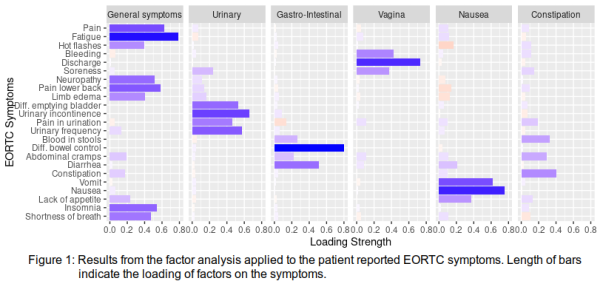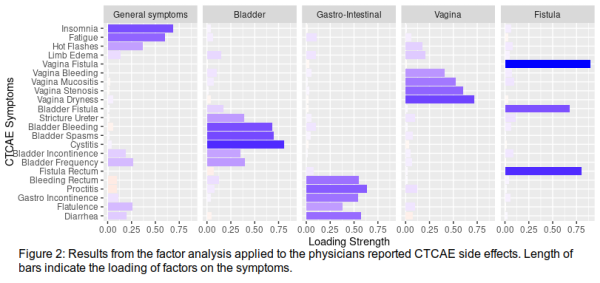Identification of syndromes from temporal evolution of symptoms in cervix cancer patients
OC-0452
Abstract
Identification of syndromes from temporal evolution of symptoms in cervix cancer patients
Authors: Marta Pelizzola1, Sofia Spampinato1, Supriya Chopra2, Remi Nout3, Kathrin Kirchheiner4, Kari Tanderup1
1Aarhus University Hospital, Danish Center for Particle Therapy, Aarhus, Denmark; 2Tata Memorial Hospital, Department of Radiation Oncology, Mumbai, India; 3Erasmus University Medical Center Rotterdam, Department of Radiation Oncology, Rotterdam, The Netherlands; 4Medical University of Vienna, Department of Radiation Oncology, Vienna, Austria
Show Affiliations
Hide Affiliations
Purpose or Objective
The aim of this study was to use factor analysis to identify sets of co-occurring symptoms over time in locally advanced cervix cancer patients, focusing particularly on multifactorial symptoms with a strong impact on quality of life (QoL).
Material and Methods
The EMBRACE I study is a multicenter prospective observational study with 1416 patients enrolled from 2008 to 2015 in 24 centers. Information on treatment, morbidity and patient reported outcome (PRO) has been prospectively assessed regularly during follow-up (in median 48 months). Data on PRO, QoL, and physician-assessed morbidity were collected using the EORTC and CTCAE v.3, respectively.
The correlation of symptoms was evaluated using factor analysis on both EORTC and CTCAE data with symptoms and follow-ups as observations. Factor analysis is a statistical method that extracts latent factors from clinically observed single symptoms, accounting for their correlations. The underlying factors represent clinical syndromes, which are groups of co-occurring symptoms. The higher the loadings of a factor on a symptom (length of bars in figures 1 and 2), the stronger the relationship between syndrome and symptom.
Factor analysis was applied on the EORTC and CTCAE data in patients where follow-up was available for all symptoms and maximum 25% missing entries.
Results
Figure 1 and 2 show six interpretable factors for EORTC (529 patients) and five for CTCAE (1182 patients), respectively. Factors related to the different organs at risk are seen for both data sets. More specifically, organ-related factors for urinary (frequency, incontinence and cystitis), gastro-intestinal (diarrhea, abdominal cramps and flatulence) and vaginal (bleeding, soreness and stenosis) morbidity are identified.
Furthermore, in both CTCAE and EORTC data, a factor corresponding to general symptoms is present with high loadings for fatigue, pain, insomnia, neuropathy, shortness of breath and hot flashes.
Despite the fact that similar symptoms reported in the EORTC and CTCAE are defined in different ways, our results of the two factor analyses show similarity between the assessment methods in terms of main factors identified both for organs at risk and general symptoms.

Conclusion
This analysis on the EORTC and CTCAE data identified syndromes which are associated with general and organ-related symptoms. Symptoms originating from a given organ often occur together, and the factor of general symptoms is consistent too. Indeed, the loadings of this factor on insomnia, fatigue and hot flashes are high in both EORTC and CTCAE, pointing to a strong influence of these symptoms in the “general symptoms” syndrome.
Factor analysis is beneficial for identifying syndromes as the longitudinal correlation between symptoms is accounted for by the latent variables. Previous analyses have shown large impact of pain, fatigue, insomnia and neuropathy on QoL. This analysis shows that these symptoms have a tendency to occur together and points towards a multifactorial nature of these symptoms.